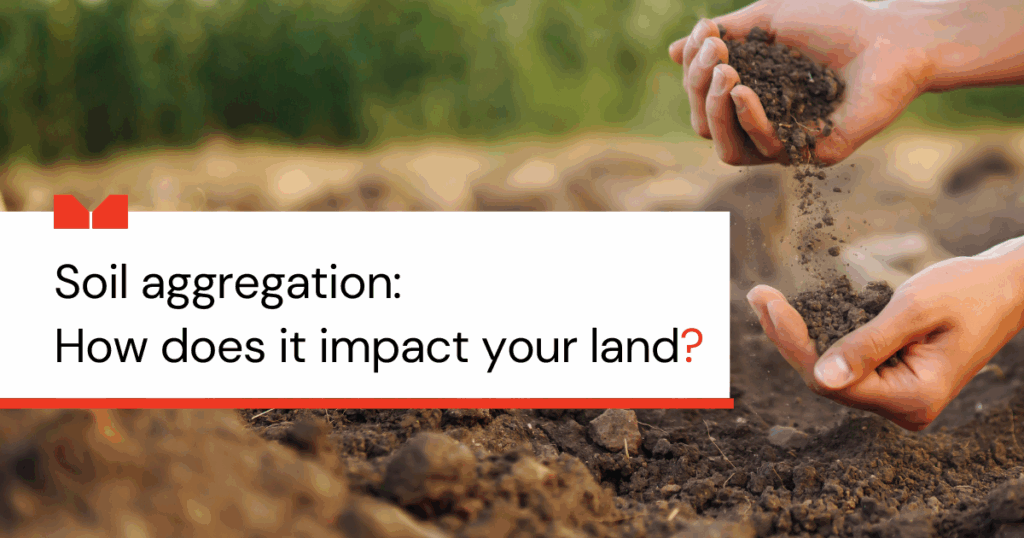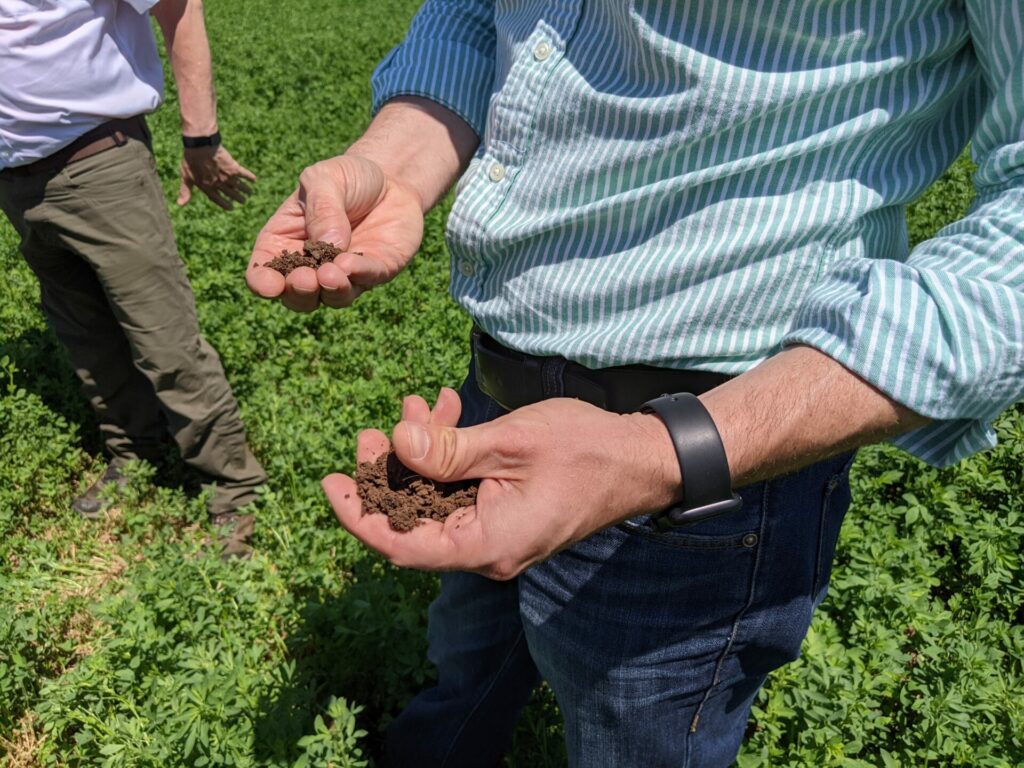
Soil Aggregation: The Foundation of Healthy, Resilient Soil
Soil is thriving, life-filled, and is estimated to be responsible for 95% of the earth’s food. Its living, breathing ecosystem supports plant growth, nutrient cycling, and water retention. For all those things to happen, though, soil needs to be healthy, and to stay healthy, something called aggregation must occur.
A good way to think about soil aggregation is to imagine walking through a farm and picking up a handful of soil. If the handful you pick up is well-aggregated soil, it will feel crumbly, light, and slightly moist, and be held together in small, stable clumps that easily break apart under the gentle pressure of your hand.
In contrast, if the soil is poorly aggregated, it will feel compacted and dense in the palm of your hand. If it is dry, it will crumble into dust and, if wet, it will feel like a sticky, heavy mass. So, what is soil aggregation?
Soil aggregation is the process that binds soil particles together to form stable structures.
This post will go into detail about soil aggregation, why it matters, and how growers can enhance the soil aggregation on their land.
Jump to
- What is soil aggregation?
- Why is soil aggregation essential for your land?
- Suspect poor aggregation on your farm? Do this self assessment.
- How does soil aggregation happen?
- How to enhance soil aggregation
What is soil aggregation?
Soil aggregation happens when sand, silt, and clay particles bind together into small clusters called aggregates. Rather than forming a solid mass, these clusters create a network of tiny channels and spaces, allowing air, water, and roots to move easily through the soil.
This open structure also provides pathways for insects, worms, and other organisms to travel, helping to maintain a dynamic underground ecosystem.
Healthy soil forms small clusters that create pores for air, water, and roots to move through—these pores make for something called soil porosity. A high level of porosity improves water retention, oxygen exchange, and nutrient availability, making the soil more productive.
Aggregation also provides a habitat for microbes, functioning like an underground network with natural plumbing that stores water and nutrients. This structure supports plant growth and maintains a balanced soil ecosystem.
Why is soil aggregation essential for your land?
Without soil aggregation, soil can become compacted, making it difficult for water to properly absorb and drain. Instead of water soaking into the soil, it pools on the surface. This can lead to runoff and erosion and is why areas with poor soil structure are more prone to flash floods.
Compacted soil can also limit root growth, making it harder for plants to access essential nutrients and moisture. Without space for air exchange, oxygen levels drop, and plant roots are cut off from beneficial microbes. Over time, this dire situation can lead to weaker crops, reduced yields, and an overall decline in soil health.
When soil aggregation is improved through a proven soil health service like MyLand, growers see:
✔️ Improved soil drainage
✔️ Decreased water use
✔️ Reduced fertilizer and water input costs
✔️ Increased profit
Suspect poor aggregation on your farm?
Do this self-assessment. Do you notice any of these indicators of poor aggregation?
- Waterlogging: Soil remains soggy because water cannot infiltrate properly.
- Salt crusts: White crusts form on the soil surface, indicating poor drainage.
- Plant water stress: Crops either become overwatered (due to lack of oxygen) or dry out quickly between irrigation cycles.
- Differences in water use efficiency: Uneven water absorption across a field suggests inconsistent aggregation.
How does soil aggregation happen?
The way soil aggregation happens is directly driven by biological, chemical, and physical factors within the soil.
Biological factors
- Microorganisms and microalgae produce sticky exopolysaccharides (EPS), which is a glue-like substance that holds soil particles together.
- Plant roots exude compounds that bind soil particles.
- Fungal hyphae (tiny threads that make up fungi) help hold soil pieces together, and a type of helpful fungi called arbuscular mycorrhizal fungi make a sticky substance called glomalin that helps keep the soil stable.
- Earthworms and soil fauna mix soil, and this helps incorporate valuable organic matter.
Chemical factors
- Organic matter serves as a natural binding agent.
- Soil minerals, particularly clay, contribute to aggregate formation.
Physical factors
- Soil’s texture, porosity, and organic matter content all impact its aggregation. Soil aggregation relies on structure and porosity; when compacted or low in organic matter, it breaks down, limiting water, air, and root movement.
- Fluctuations in water levels can either promote or damage aggregation.

Challenges to maintaining soil aggregation
Soil aggregation relies on biological life, moisture, and organic matter underground. Microbes, fungi, and plant roots produce natural compounds that bind soil particles, creating stable aggregates. When soil lacks these living organisms or enough organic material, aggregation weakens, making it harder for soil to hold water and nutrients.
Water availability also plays a key role. Too much water can break down aggregates, while too little can cause soil to dry out and compact. Without strong aggregation, soil erodes more easily, washing away valuable topsoil and reducing fertility. Over time, this makes it harder for plants to grow and for soil to recover.
How to enhance soil aggregation
Farmers can take several steps to improve soil aggregation and overall soil health:
- Add organic matter: Compost, manure, and cover crops boost soil organic content, fostering microbial activity.
- Reduce soil disturbances: This helps maintain stable aggregates.
- Introduce Microbial Solutions: Beneficial microbes, including microalgae, enhance natural aggregation processes.
- Grow cover crops: The roots and plant biomass contribute to aggregate stability. Microalgae act as an under-ground cover crop, providing benefits in areas where traditional cover cropping may not be possible (or an additional boost on farms that employ both practices).
- Diversify crop rotations: Different root structures support varied microbial communities, improving soil structure.
Benefits of improving soil aggregation
Improving soil aggregation offers numerous benefits for both soil health and crop production. A strong soil structure enhances root access to water and nutrients, leading to higher crop yields. Aggregates also improve the soil’s water-holding capacity, reducing the need for irrigation and making crops more resilient to drought. Additionally, better soil aggregation supports microbial life and nutrient cycling, which are essential for long-term soil health.
The ability of aggregates to store organic carbon helps mitigate climate change, while the looser soil structure promotes better root growth. Well-aggregated soils are also more resistant to erosion caused by wind and water, ensuring a more stable and productive environment for crops.
The bottom line & what’s next?
Soil aggregation is the backbone of what makes soil healthy. By prioritizing soil structure, farmers can boost yields, conserve water, and promote a thriving underground ecosystem. Start by checking your soil, and then make improvements to increase organic matter, incorporate cover crops, and take other steps to enhance soil aggregation.
If you’ve been down the path of using chemical fertilizers and need a new way to improve crop quality, consider connecting with MyLand Soil as a Service™. Our soil health solution is focused on improving the profitability of your farm through live, native microalgae.

News for Washington State farmers
The state may be funding your first year of MyLand Soil as a Service™. Washington growers, get information about this program and call (509) 688-0866 to see if you qualify before June 2025.